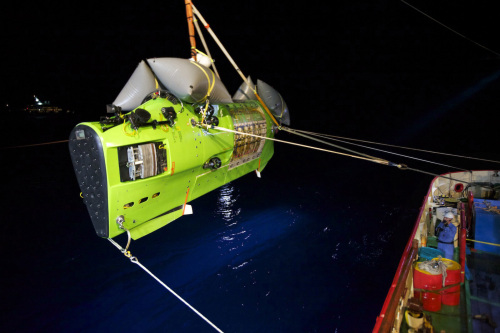‘Titanic’ director dives to Pacific’s deepest point
By Korea HeraldPublished : March 26, 2012 - 19:16
WASHINGTON (AFP) ― “Titanic” director James Cameron has safely returned to the ocean surface after a solo submarine dive to the deepest part of the Pacific Ocean, expedition organizers said Monday.
“Jim Cameron has surfaced! Congrats to him on his historic solo dive to the ocean’s deepest point,” said a Twitter message from Deep Sea Challenge, which organized the dive.
Cameron is the first person to make a solo dive to the Pacific Ocean valley known as the Challenger Deep, southwest of Guam. And the last dive of any kind there was a relatively brief two-person team back in 1960.
After a faster-than-expected, roughly 70-minute ascent, Cameron’s sub, bobbing in the open ocean, was spotted by helicopter and was expected to soon be plucked from the Pacific by a research ship’s crane, organizers said.
“Jim Cameron has surfaced! Congrats to him on his historic solo dive to the ocean’s deepest point,” said a Twitter message from Deep Sea Challenge, which organized the dive.
Cameron is the first person to make a solo dive to the Pacific Ocean valley known as the Challenger Deep, southwest of Guam. And the last dive of any kind there was a relatively brief two-person team back in 1960.
After a faster-than-expected, roughly 70-minute ascent, Cameron’s sub, bobbing in the open ocean, was spotted by helicopter and was expected to soon be plucked from the Pacific by a research ship’s crane, organizers said.

Mission partner the National Geographic said Cameron had reached a depth of 10,898 meters at 7:52 am Monday (2152 GMT Sunday) in the Mariana Trench in his specially designed submersible.
Because of its extreme depth, the Mariana Trench is cloaked in perpetual darkness and the temperature is just a few degrees above freezing, according to members of the team.
The water pressure at the bottom of the trench is a crushing eight tons per square inch ― or about a thousand times the standard atmospheric pressure at sea level. Pressure increases with depth.
Cameron spent several hours on the Pacific Ocean sea floor, collecting samples for scientific research and taking still photographs and moving images.
His goal was to bring back data and specimens from the unexplored territory. He is expected to announce the results of the experiment later.
The tools taken by the explorer to the ocean floor included a sediment sampler, a robotic claw, a “slurp gun” for sucking up small sea creatures for study at the surface, and temperature, salinity, and pressure gauges.
Now “the science team is getting ready for the returned samples,”expedition astrobiologist Kevin Hand from NASA said in an email.
Upon touchdown, Cameron’s first target was a phone booth-like unmanned “lander” dropped into the trench hours before his dive.
The submersible that Cameron designed, a “vertical torpedo” of sorts, had already successfully completed an unpiloted dive on Friday.
In 1960, a two-person crew aboard the U.S. Navy submersible Trieste ― the only humans to have reached Challenger Deep ― spent just 20 minutes on the bottom, but their view was obscured by silt stirred up when they landed.
Retired U.S. Navy Captain Don Walsh, who descended to Challenger Deep in 1960, said he was pleased to hear that Cameron had reached the underwater valley safely.
-
Articles by Korea Herald








![[Graphic News] More Koreans say they plan long-distance trips this year](http://res.heraldm.com/phpwas/restmb_idxmake.php?idx=644&simg=/content/image/2024/04/17/20240417050828_0.gif&u=)
![[KH Explains] Hyundai's full hybrid edge to pay off amid slow transition to pure EVs](http://res.heraldm.com/phpwas/restmb_idxmake.php?idx=644&simg=/content/image/2024/04/18/20240418050645_0.jpg&u=20240419100350)






![[From the Scene] Monks, Buddhists hail return of remains of Buddhas](http://res.heraldm.com/phpwas/restmb_idxmake.php?idx=652&simg=/content/image/2024/04/19/20240419050617_0.jpg&u=20240419175937)

![[KH Explains] Hyundai's full hybrid edge to pay off amid slow transition to pure EVs](http://res.heraldm.com/phpwas/restmb_idxmake.php?idx=652&simg=/content/image/2024/04/18/20240418050645_0.jpg&u=20240419100350)

![[Today’s K-pop] Illit drops debut single remix](http://res.heraldm.com/phpwas/restmb_idxmake.php?idx=642&simg=/content/image/2024/04/19/20240419050612_0.jpg&u=)